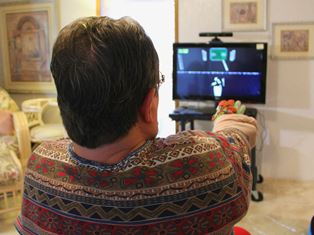3D video game helps restore muscle function in stroke patients
18 November 2013
Researchers at The Ohio State University Wexner Medical Center have developed a video game so that stroke patients with muscle weakness can have therapy at home to build strength in the affected hand or arm.
The condition, called hemiparesis, affects 325,000 people each year in the US, according to the National Stroke Association. It is defined as weakness or the inability to move one side of the body, and can be debilitating as it impacts everyday functions such as eating, dressing or grabbing objects.
Constraint-induced movement therapy (CI therapy) is an intense
treatment recommended for stroke survivors, and improves motor
function, as well as the use of impaired upper extremities. However,
less than 1% of those affected by hemiparesis receives the
beneficial therapy.
“Lack of access, transportation and cost
are contributing barriers to receiving CI therapy. To address this
disparity, our team developed a 3D gaming system to deliver CI
therapy to patients in their homes,” said Lynne Gauthier, assistant
professor of physical medicine and rehabilitation in Ohio State’s
College of Medicine.
Gauthier, also principal investigator of the study and a neuroscientist, is collaborating with a multi-disciplinary team comprised of clinicians, computer scientists, an electrical engineer and a biomechanist to design an innovative video game incorporating effective ingredients CI therapy.
For a combined 30 hours over the course of two weeks, the patient-gamer is immersed in a river canyon environment, where he or she receives engaging high repetition motor practice targeting the affected hand and arm.
Various game scenarios promote movements that challenge the stroke survivor and are beneficial to recovery. Some examples include: rowing and paddling down a river, swatting away bats inside a cave, grabbing bottles from the water, fishing, avoiding rocks in the rapids, catching parachutes containing supplies and steering to capture treasure chests.
Throughout the intensive training schedule, the participant wears a padded glove on the less affected hand for 10 hours daily, to promote the use of the more affected hand.
To ensure that motor gains made through the game carry over to daily life, the game encourages participants to reflect on their daily use of the weaker arm and engages the gamer in additional problem-solving ways of using the weaker arm for daily activities.

A patient undergoing rehabilitation by playing
the video game
“This novel model of therapy has shown positive results for individuals who have played the game. Gains in motor speed, as measured by the Wolf Motor Function Test, rival those made through traditional CI therapy,” said Gauthier. “It provides intense high quality motor practice for patients, in their own homes. Patients have reported they have more motivation, time goes by quicker and the challenges are exciting and not so tedious.”
Gauthier said that, if this initial trial demonstrates sufficient evidence of efficacy in stroke survivors, future expansion of gaming CI therapy is possible for other patients with traumatic brain injury, cerebral palsy and multiple sclerosis.